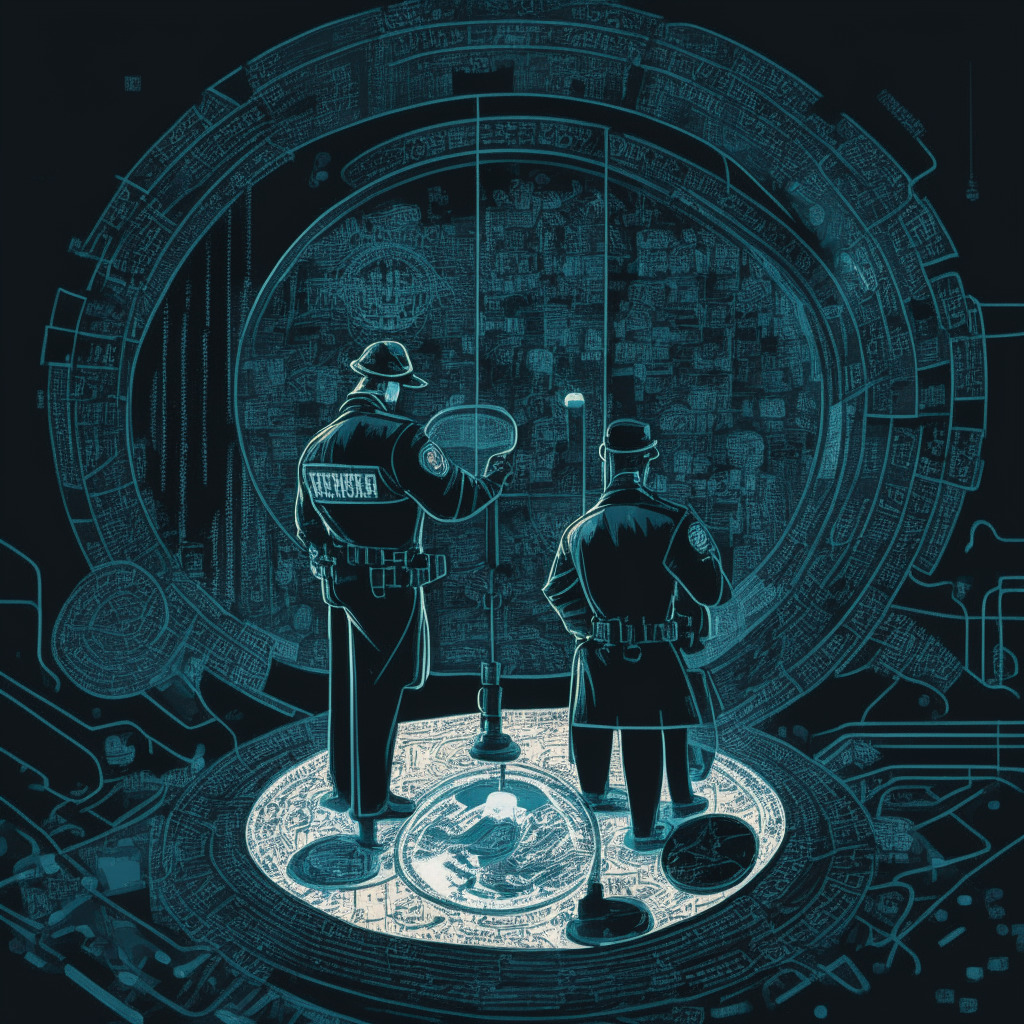Recently, a crypto lender, SwirlLend, scammed the newly launched Base platform, resulting in a significant loss of cryptocurrency and trust. This incident, second in a few days, has raised security concerns and emphasizes the necessity for robust cybersecurity measures in the crypto realm.
Category: Security
Untangling WhiteBIT’s Extravagant Promises: The Involved Risks and Rewards in Crypto Lending Platforms
The WhiteBIT platform, connected with crypto figure Justin Sun, promises an alarming 24.8% APY for Tether deposits, tripling the average USD rate. Made noteworthy due to Sun’s history of promoting risky stablecoins, WhiteBIT’s extremely high returns warrant intensive scrutiny from informed investors.
Ethereum Layer 2 Lending Scam: SwirlLend’s Exit Raises DeFi Ecosystem Red Flags
“The Ethereum Layer 2 lending project, SwirlLend, allegedly perpetrated an exit scam, leading to user losses around $460,000. The scam was exposed by cyber-security firm PeckShield, revealing suspicious activities such as the sudden disappearance of SwirlLend’s social media presence. This incident emphasizes the ever-present risk in the DeFi ecosystem and the importance of due diligence.”
Securing the Gatekeepers: Safeguarding Your Cryptocurrency Private Keys
“Private keys in the digital asset universe are secure gatekeepers, providing access to your prized cryptocurrencies and data. Secure storage methods include hardware wallets, paper wallets, encrypted USB drives, cold storage, cryptocurrency vault services, password managers, and key-splitting. Your choice should consider your specific needs, tech expertise, and risk tolerance.”
Unmasking the Phantom Menace: The Uncanny Links Among Crypto Scammers & the Fight to Secure Blockchain
“In the world of cryptocurrencies, anonymous scammers like “Faint” pose significant threats, having reportedly stolen approximately $1M in digital currencies. Blockchain security firm CertiK underscores the need for proactive measures, such as Wallet Guard and Pocket Universe, to alert users of potential threats. Balancing security and privacy remains an ongoing challenge in the cryptoverse.”
Balancing Crypto Security: De.Fi’s Antivirus Tool and User Responsibility on zkSync Era Blockchain
De.Fi’s antivirus tool can safeguard users from malicious exploits such as phishing in the crypto industry by providing an additional layer of security. This tool functions by connecting wallets or scanning smart contract addresses on the De.Fi platform. However, successful risk mitigation also relies on the users’ own due diligence and vigilance.
Decrypting Privacy: Navigating the Complexities of Blockchain and Cryptocurrency Security
“The rise of blockchain technology has revolutionized financial transactions but also raises privacy concerns. Transactions are logged on public ledgers, implying transactions can be traced back to specific addresses. Strategies for maintaining privacy include using encryption tools, maintaining wallet anonymity, and exploring privacy-focused cryptocurrencies, also considering DeFi platform exposures.”
Navigating the Cryptocurrency Wilderness: Recognizing Red Flags and Authenticating Genuine Projects
In the expanding cryptocurrency world, detecting scams involves assessing a project’s team transparency, scrutinizing the white paper, checking technical explanations, community engagement, and regulatory compliance. Beware of tactics promising risk-free high returns and projects lacking tangible token use or financial progress transparency. Always research thoroughly before investing.
Unmasking the Zunami Protocol Price Manipulation: Over $2.1 Million Lost in Cyber-Offensive
The Decentralized Finance (DeFi) platform Zunami Protocol has suffered a price manipulation attack involving its stablecoin pools on Curve Finance, leading to potential losses of over $2.1 million. The exploit participants reportedly used a flash loan to significantly alter the price, resulting in stolen funds. The event underscores the necessity of stringent security measures for DeFi ecosystems.
Securing the Cryptosphere: Crypto-Heists & How to Mitigate Future Threats
“The recent $62 million hack of Curve Finance highlights a pressing need for improved security in the cryptocurrency landscape. The considerable financial damage reveals potential vulnerabilities in DeFi platforms. Despite nearly 79% of funds successfully recovered, this unfortunate incident brings attention to the preparedness of DeFi sector against sophisticated threats.”
Dissecting DeFi Security: An Unnerving Ride with Hacks, Investments, and Future Safety Measures
“In the face of security breaches in the DeFi sector, such as the infamous Curve Finance hack, the industry remains resilient. Major developments include Binance’s $5 million investment in Curve, and collaborations between Aptos and Microsoft for Web3 solutions. Despite the security challenges, the sector continues striving for its ambitious goals, while addressing the critical necessity of transactional security.”
Crypto Theft Recovery: A Tale of Hope and Caution in Blockchain Security
A recent hacking incident involving the theft of 90 Ether (ETH) has highlighted a potential method of recovering stolen blockchain funds. The victim managed to get the hacker’s wallet blacklisted with the aid of authorities, effectively freezing the stolen assets. This case emphasizes the need for diligent security measures and effective blockchain regulations, as well as the necessity for tech companies and digital asset holders to take responsibility for platform security.
AI-Powered Scam Hunting: The Battle Against Crypto Giveaway Frauds on Social Platforms
San Diego State University researchers have leveraged artificial intelligence to identify over 95,000 cryptocurrency scam cases on social networking platforms. This AI system, termed GiveawayScamHunter, aids in recognizing scams by sifting through user data associated with identified prize scams, enhancing understanding of scammers’ techniques and stressing on user safety and caution.
Unmasking Telegram Trading Bots: Unprecedented Crypto Marketplace or Security Nightmare?
“Telegram trading bots have ignited interest in the crypto marketplace, but they also bring significant security concerns. Questions arise around their storage of private keys and centralization. If a user’s Telegram gets hacked, they risk losing their funds.”
Unmasking BitForge: The Hidden Vulnerabilities of Multi-Party Computation Technology in Crypto Wallets
Fireblocks, a crypto infrastructure company, exposed vulnerabilities, known as “BitForge”, in crypto wallets that use multi-party computation (MPC) technology. High-profile firms including Coinbase, ZenGo, and Binance quickly partnered with Fireblocks to counter these vulnerabilities, thus safeguarding against potential exploitation. The vulnerabilities highlighted safety issues about the previously assumed secure MPC wallets.
Unmasking the BitForge Vulnerability: A Wake-up Call for Crypto Wallet Security
“Blockchain security firm, Fireblocks, revealed a vulnerability in crypto wallets using multi-party computation (MPC) technology, affecting major wallets like Coinbase and Binance. Rapidly addressed, the incident underscores the inherent risks in the Web3 domain and the importance of vigilance and proactive security measures in crypto.”
BitForge Vulnerabilities Exposed: Revisiting Crypto Wallet Security and the Future of MPC Technology
Fireblocks, a crypto infrastructure company, exposed a series of vulnerabilities, termed BitForge, in commonly used crypto wallets running on multi-party computation (MPC) technology. Posing a risk of enabling untraceable funds withdrawals, these vulnerabilities challenge the reliability and security of ‘ultra-safe’ MPC wallets and prompt a review of crypto security safeguards.
AI Deepfakes: A New Threat to Cryptocurrency Security Verification Systems
Binance CEO, Changpeng Zhao, has expressed concern over the potential threats AI-generated deepfake videos pose to cryptocurrency security. The advanced AI technology evident in the avatar and voice clone unveiled by HeyGen’s CEO could exploit loopholes in user verification processes. CoinGecko’s FAKEAI demonstrates the commercial potential of this technology, however, escalating AI capabilities present substantial security challenges within the crypto realm.
Crypto Wallets Under Siege: Unpacking Security Testing & Vulnerability in Digital Finance
“A recent report by CER revealed that only six out of 45 reviewed crypto wallets conducted penetration testing to identify security vulnerabilities. Despite the alarming number, some wallet brands are using alternative methods like bug bounties to uncover vulnerabilities, thereby raising questions about the effectiveness of current security strategies in protecting digital assets.”
The Curve conundrum: A DeFi Chronicle – Debunking Untouched Vulnerabilities and the Road Ahead
Last month, renowned decentralized exchange, Curve, suffered a hack that led to a loss exceeding $70 million, sending its native token, CRV, into a sharp downward spiral. While ongoing risky lending practices compounded the concern, Curve made a remarkable recovery, recovering almost 75% of the lost assets. This incident underscores the vulnerabilities within DeFi platforms and the importance of preparedness for unexpected events in the decentralized finance space.
Reentrancy Attack Plunders Aave Earning Farm: DeFi’s Security Dilemma Unraveled
The blockchain-driven DeFi world, particularly the Aave protocol’s Earning Farm, recently fell victim to a reentrancy attack, leading to a loss of $287,000. This attack, which mirrors previous exploits on other platforms, highlights significant security vulnerabilities in the DeFi sector.
Harnessing Blockchain for Crime-Busting: Canada’s Progressive Approach and Privacy Concerns
Canadian law enforcement is utilizing the Chainalysis Reactor software to trace cryptocurrency crimes, adding a significant layer of accountability to the digital asset world. This technology reviews transaction patterns and tracks digital currencies to illegal activities, aiding investigations significantly. Despite potential criticisms of overregulation and privacy concerns, this marks noteworthy progress.
Deepfakes and Cryptocurrency: The Dual-edge Sword of AI in Secure Identification Verification
“The advent of AI brings risks to personal security, especially in cryptocurrency exchanges where deepfake personas can disrupt the authentication process. The Know-Your-Customer (KYC) measures, employed by exchanges like Binance, are increasingly vulnerable due to AI’s advancement.”
Navigating Online Hazards: Phishing Scams Pose Threat to Crypto Community and Market Trust
“In a bold phishing scam, Blockchain Capital’s Twitter was hijacked with the hackers constructing a sham giveaway to exploit the public. The incident, echoing recent FBI warnings about scams in the crypto and NFT space, underlines the importance of robust cybersecurity in the increasingly mainstream world of crypto technology.”
The Unsettling Reality of Crypto Hacks: Unraveling the CoinsPaid Heist
“The Ukrainian firm CoinsPaid fell victim to a cyber heist that resulted in an estimated loss of $37.3 million in crypto assets. The attack was reportedly orchestrated via social engineering attempts using LinkedIn and involved malicious usage of software called JumpCloud. It’s believed that this crime mirrors the tactics of the North Korean Lazarus Group, highlighting the evolving complexity of cybercrime in the digital marketplace.”
Forta Network Amplifies Scam Detection: A Leap Forward or a Perpetual Tightrope Walk?
“Forta Network has enhanced its scam detection services by expanding its threat focus and incorporating malicious URL data. The service employs real-time threat detection across seven Ethereum Virtual Machine chains, and uses predictive techniques and new smart contract scanners to identify potential crypto threats.”
The Hidden Dangers of AI-Powered Chrome Extensions: Your Convenience vs. Your Security
“According to Incogni, 69% of AI-powered extensions for Google Chrome present high-risk security threats in case of a breach. The study found that 59% of these extensions collect user data, with 44% harvesting personally identifiable information (PII). This underscores the importance of understanding the range of data shared with extensions and their ability to protect it.”
Cybersecurity Challenges in Crypto: The Cypher Protocol Breach and its Implications on Other Players
“Cypher Protocol, a Solana-based decentralized exchange, paused operations due to a security breach, with estimated losses of $1 million. Details remain scarce but blockchain explorers suggest funds have begun moving, possibly indicating liquidation attempts. This increases the recent losses suffered by the crypto-community, emphasizing the need for improved security measures in the growing blockchain space.”
The Dark Side of PayPal’s PYUSD: Counterfeit Tokens and Deception in the Crypto Landscape
PayPal’s announcement of their USD-pegged stablecoin has led to an increase in counterfeit tokens purporting to be PYUSD on various networks. Fraudulent elements use these tokens to lure unsuspecting users on decentralized exchanges, fostering an environment of perceived legitimacy. Investors should remain vigilant to avoid falling prey to such scams.
Influx of Counterfeit PYUSD Tokens: A Hazard or Humor in the Crypto World?
The launch of PayPal’s new stablecoin, PYUSD, has led to the creation of numerous counterfeit tokens across various blockchain platforms. Investors must be cautious as these imitation tokens could be traps that result in losses, underlining the importance of due diligence before investing.
Massive Security Breach: Lessons from the One-Million-Dollar Crypto Heist at Cypher Protocol
“Cypher Protocol, a decentralized futures exchange, experienced a one million-dollar security breach, highlighting vulnerabilities in even well-designed blockchain systems. Such incidents underline the need for continuous innovation in defense mechanisms and proactive asset recovery measures in the blockchain space. They also stress the complexity of tracking blockchain crimes without compromising privacy.”
Cypher’s Crypto Robbery During Hacker House: Unveiling Blockchain Security Pros, Cons and Controversies
“A security incident resulted in the loss of $400,000 from Cypher, a Solana-based decentralized exchange. Seeing Cypher’s team attempt to negotiate with the hackers highlights the importance of robust security and reveals that asset recovery is possible with careful strategy, despite potential risks.”































